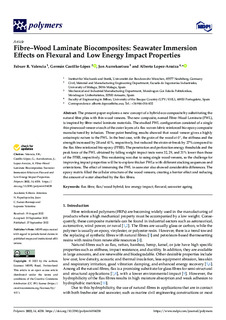| dc.rights.license | Attribution 4.0 International | * |
| dc.contributor.author | Aurrekoetxea, Jon | |
| dc.contributor.other | Valencia, Fabuer R. | |
| dc.contributor.other | Castillo López, German | |
| dc.contributor.other | López Arraiza, Alberto | |
| dc.date.accessioned | 2023-03-21T13:17:26Z | |
| dc.date.available | 2023-03-21T13:17:26Z | |
| dc.date.issued | 2022 | |
| dc.identifier.issn | 2073-4360 | en |
| dc.identifier.other | https://katalogoa.mondragon.edu/janium-bin/janium_login_opac.pl?find&ficha_no=171946 | en |
| dc.identifier.uri | https://hdl.handle.net/20.500.11984/6049 | |
| dc.description.abstract | The present paper explores a new concept of a hybrid eco-composite by substituting the natural fibre plies with thin wood veneers. The new composite, named Fibre–Wood Laminate (FWL), is inspired by fibre–metal laminate materials. The studied FWL configuration consisted of a single thin pinewood veneer at each of the outer layers of a flax woven fabric reinforced bio-epoxy composite manufactured by infusion. Three-point bending results showed that wood veneer gives a highly anisotropic nature to the FWL. In the best case, with the grain of the wood at 0°, the stiffness and the strength increased by 28 and 41%, respectively, but reduced the strain-at-break by 27% compared to the flax fibre reinforced bio-epoxy (FFRB). The penetration and perforation energy thresholds and the peak force of the FWL obtained by falling weight impact tests were 32, 29, and 31% lower than those of the FFRB, respectively. This weakening was due to using single wood veneers, so the challenge for improving impact properties will be to explore thicker FWLs with different stacking sequences and orientations. The effect of immersing the FWL in seawater also showed considerable differences. The epoxy matrix filled the cellular structure of the wood veneers, creating a barrier effect and reducing the amount of water absorbed by the flax fibres. | en |
| dc.description.sponsorship | Gobierno Vasco-Eusko Jaurlaritza | es |
| dc.language.iso | eng | en |
| dc.publisher | MDPI | en |
| dc.rights | © 2022 The Authors | en |
| dc.rights.uri | http://creativecommons.org/licenses/by/4.0/ | * |
| dc.subject | flax fibre | en |
| dc.subject | flax/wood hybrid | en |
| dc.subject | low energy impact | en |
| dc.subject | flexural | en |
| dc.subject | seawater ageing | en |
| dc.title | Fibre-Wood Laminate Biocomposites: Seawater Immersion Effects on Flexural and Low Energy Impact Properties | en |
| dcterms.accessRights | http://purl.org/coar/access_right/c_abf2 | en |
| dcterms.source | Polymers | en |
| local.contributor.group | Tecnología de plásticos y compuestos | es |
| local.description.peerreviewed | true | en |
| local.identifier.doi | https://doi.org/10.3390/polym14194038 | en |
| local.relation.projectID | info:eu-repo/grantAgreement/GV/Ikertalde Convocatoria 2022-2025/IT1613-22/CAPV/ | en |
| local.contributor.otherinstitution | https://ror.org/05kkv3f82 | de |
| local.contributor.otherinstitution | https://ror.org/036b2ww28 | es |
| local.contributor.otherinstitution | https://ror.org/000xsnr85 | eu |
| local.source.details | Vol. 14. N. 19. Artículo 4038 | en |
| oaire.format.mimetype | application/pdf | en |
| oaire.file | $DSPACE\assetstore | en |
| oaire.resourceType | http://purl.org/coar/resource_type/c_6501 | en |
| oaire.version | http://purl.org/coar/version/c_970fb48d4fbd8a85 | en |








